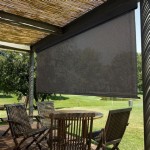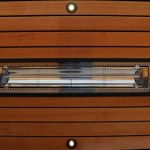What Size Patio Umbrella For 6 Person Table And Chairs
Selecting the appropriate patio umbrella size for a 6-person table and chairs is a crucial step in creating a comfortable and functional outdoor living space. The right umbrella not only provides ample shade, protecting individuals from the sun's harmful rays, but also enhances the overall aesthetic appeal of the patio area. Choosing an umbrella that is too small will result in inadequate shade coverage, while an umbrella that is too large can overwhelm the space and become unwieldy. Therefore, careful consideration must be given to various factors to ensure the selection of an umbrella that perfectly complements the table and chairs.
The size of a 6-person patio table typically ranges from 48 to 60 inches in diameter if it is round, or 60 to 72 inches long if it is rectangular or oval. This measurement serves as the foundation for determining the appropriate umbrella size. An umbrella should ideally extend at least two feet beyond the table's edge on all sides. This overhang provides sufficient shade for individuals seated at the table, even as the sun moves throughout the day.
Beyond the table size itself, other factors such as the table's placement relative to the sun's path, the height of the surrounding structures, and personal preferences for shade coverage play a significant role in making the final decision. By understanding these considerations, individuals can effectively navigate the available options and choose a patio umbrella that effectively meets their specific needs and enhances their outdoor enjoyment.
Determining Minimum Umbrella Size Based on Table Dimensions
Calculating the minimum acceptable umbrella size begins with a precise assessment of the table's dimensions. For round tables, the diameter is the governing measurement. For rectangular or oval tables, both the length and width must be considered. Once these dimensions are known, a fundamental rule of thumb can be applied: the umbrella's diameter should exceed the table's diameter or longest dimension by at least four feet (two feet on each side).
Let’s consider a round table with a diameter of 54 inches. Applying the rule, adding four feet (48 inches) to the table diameter results in a minimum umbrella diameter of 102 inches (54 inches + 48 inches). Since umbrellas are typically sold in standard sizes, the closest available size that meets or exceeds this minimum would be selected, often a 9-foot (108-inch) or 10-foot (120-inch) umbrella.
Similarly, for a rectangular table measuring 60 inches in length and 40 inches in width, the longer dimension (60 inches) is used for the initial calculation. Adding four feet (48 inches) results in a minimum required umbrella diameter of 108 inches. Again, a 9-foot or 10-foot umbrella would be a suitable choice. It is crucial to remember that these calculations provide a minimum baseline. The actual optimal size might be larger, depending on additional factors.
It is also important to consider the shape of the umbrella canopy itself. While the listed size refers to the diameter, some umbrellas may have a more square or rectangular canopy shape. In these cases, ensure that the canopy's dimensions provide adequate coverage beyond all edges of the table.
Considering Sun Angle and Placement of the Table
The position of the sun throughout the day significantly influences the effectiveness of a patio umbrella. A table positioned in an area that receives direct sunlight from multiple angles will require a larger umbrella to provide adequate shade. In contrast, a table located in a partially shaded area, perhaps near a building or under a tree, might require a smaller umbrella. Understanding the sun's path is thus essential.
To assess the sun angle, observe the area throughout the day. Note the times when the table receives direct sunlight and from which direction the sunlight originates. If the table is exposed to direct sunlight from both the east and west, a larger umbrella will be necessary to provide shade during both morning and afternoon hours. Moreover, the tilt function of the umbrella becomes increasingly important in these scenarios. A tilting mechanism allows the umbrella canopy to be adjusted to block the sun's rays as the sun moves across the sky.
The placement of the table also affects the necessary umbrella size. A table located in an open area with no surrounding structures to provide additional shade will require a larger umbrella than a table positioned near a wall or fence that already blocks some sunlight. Consider the height of any surrounding structures as well. A tall building might cast a shadow on the patio during certain times of the day, reducing the need for a large umbrella.
Furthermore, the time of year impacts the sun's angle, with the sun being lower in the sky during the winter months. This lower angle means that the sun's rays will penetrate further under the umbrella canopy. If the patio is used year-round, it is recommended to choose a larger umbrella or one with a more pronounced tilt function to account for these seasonal variations.
Accounting for Personal Preferences and Aesthetic Considerations
Beyond the technical aspects of table size and sun angle, personal preferences play a crucial role in determining the ideal patio umbrella size. Some individuals prefer maximum shade coverage, opting for a larger umbrella that provides ample protection from the sun's rays even during peak hours. Others prioritize a more open and airy feel, preferring a smaller umbrella that provides just enough shade without obstructing the view or making the space feel enclosed.
The overall aesthetic of the patio area is another important factor to consider. The umbrella should complement the style of the table and chairs, as well as the surrounding landscaping and architecture. A large, imposing umbrella might overwhelm a small patio, while a small, understated umbrella might get lost in a large outdoor space. The color and style of the umbrella canopy should also be carefully chosen to coordinate with the existing décor.
Consider the material of the umbrella canopy as well. Lighter colored fabrics reflect more sunlight, providing a cooler shade, while darker colored fabrics absorb more sunlight, potentially making the area underneath the umbrella feel warmer. The material’s UV protection rating is also a critical consideration. Look for fabrics that offer a high UPF rating to ensure adequate protection from harmful UV rays.
Finally, factor in the potential for future changes. If there are plans to add more seating or expand the patio area in the future, it might be wise to choose a larger umbrella that can accommodate these potential changes. This approach avoids the need to purchase a new umbrella in the near future. Furthermore, consider the ease of use and maintenance. A larger umbrella will be heavier and may require more effort to open, close, and store. Choosing a durable and weather-resistant umbrella will minimize the need for frequent repairs or replacements.

The Ultimate Umbrella Size Guide You Are Looking For

Patio Umbrella Size Guide Midtown Umbrellas

Mf Studio 8 Piece Outdoor Dining Set With 13 Ft Umbrella Six Swivel Cushioned Chairs Table For 6 Person All Weather Patio Furniture Black Beige

Patio Umbrella Size Guide Midtown Umbrellas

Patio Umbrella Size Guide Find Your Perfect Fit

Patio Umbrella Size Guide Midtown Umbrellas

Outdoor Table With Umbrella Hole 6 Person Garden Dining Rectangular Patio W

6 Person Wooden Picnic Table Set With Bench And Umbrella Hold Patio Furniture At Com

Complete Guide To Patio Tables Bonus Styling Tips

Bahama Black Metal 6 Seater Dining Set With Parasol
Related Posts








